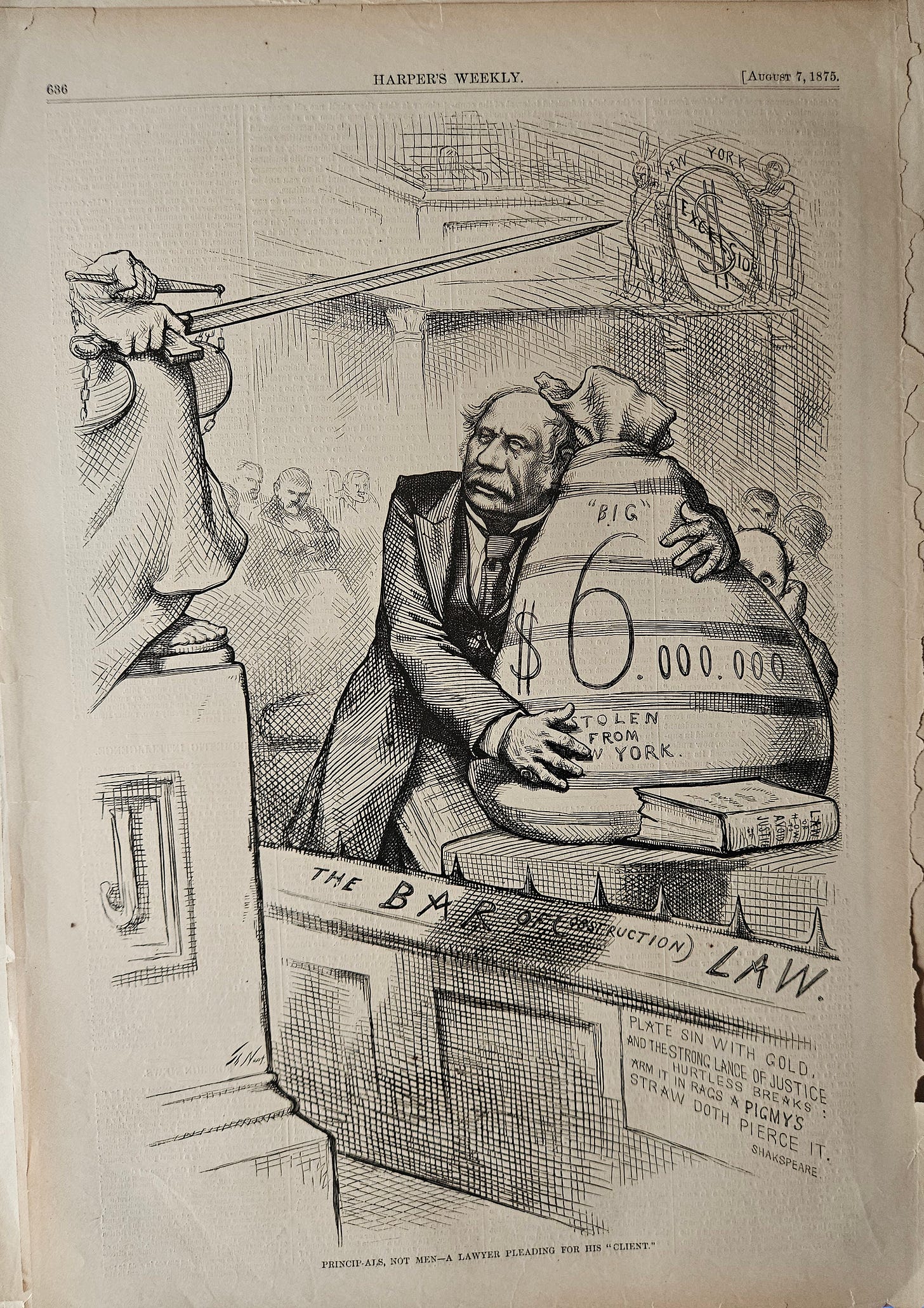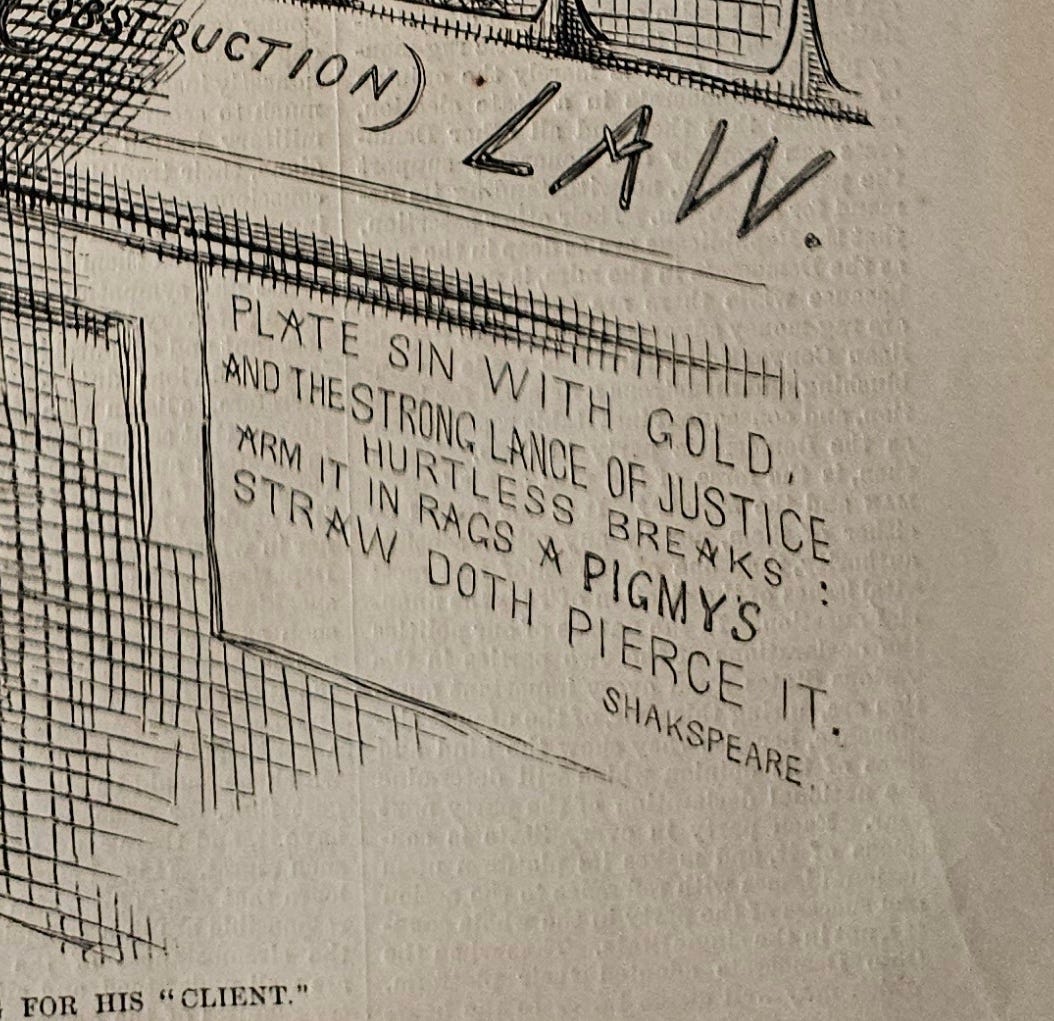NAST DRAWING: August 7, 1875. "Princip-als, Not Men--A Lawyer Pleading for his "Client." Harper's Weekly Interior Page Cartoon Lampooning The Lawyer Defending The Tweed Ring.
Nast was a vehement opponent of political corruption & made a crusade out of trying to bring down the "Boss" Tweed ring of Tammany Hall Democrats In NYC.
The cartoonist THOMAS NAST (1840-1902) was in his heyday a political institution, with each of his pictures helping to form public opinion. His influence reached its height in the late 1860s and early 1870s with his relentless caricatures of Boss Tweed and the Tammany Hall Ring in New York City.
One part of Nast’s work not often highlighted but as brilliant as the rest is his legal cartoons. Nast’s best work was done with high moral zeal, and his satire of lawyers and the legal system was no exception. His attacks grew out of frustration with the ineffectiveness of legal remedies against the Ring. He was especially incensed that prominent lawyers such as David Dudley Field (pictured here) who not only were willing to represent members of the Ring, but could cleverly exploit legal technicalities of their own making to win advantage. Nast excoriated the corruption and bribery of the bench by the Ring, and also, more generally, the adversarial system as it was developing in America.
In this cartoon he shows a teary eyed David Dudley Field pleads Tweed's case while being surrounded by the stolen sum & law books of obstruction, at the bar of (Obstruction) Law. Tweed is peaking over the right side of the sack of money. The Tweed Ring were estimated to have looted 200 MILLION dollars from NYC between 1868 & 1873. Field himself was a respected reformer Field, but was part of the team of defense counsel that William M. Tweed assembled to defend himself during the first criminal prosecution of Tweed in 1873. This first trial ended when the jury could not agree on a verdict. In a second trial, Tweed received a sentence of twelve years in prison and a $12,750. During his brief Congressional career he delivered six speeches (all of which attracted attention), introduced a bill in regard to the presidential succession, and appeared before the 1876 Electoral Commission in Samuel J. Tilden's interest during the highly controversial "Disputed" presidential election.
——-
Who was Thomas Nast and why was he important?
Thomas Nast (1840-1902) was a political cartoonist considered to be the "Father of the American Cartoon.” Born in Landau, Germany, Nast's family immigrated to New York City when he was six. Nast showed an interest in drawing from an early age, but much less so in school, dropping out at the age of 14.
What was Tammany Hall and what did it do?
It became the main local political machine of the Democratic Party and played a major role in controlling New York City and New York State politics. It helped immigrants, most notably the Irish, rise in American politics from the 1850s into the 1960s.
———-
FROM InValuable
WILLIAM MAGEAR TWEED (1823-1878), often erroneously referred to as "William Marcy Tweed", and widely known as "Boss" Tweed, was an American politician most notable for being the "boss" of Tammany Hall, the Democratic Party political machine that played a major role in the politics of 19th-century NYC and State. At the height of his influence, Tweed was the third-largest landowner in NYC, a director of the Erie Railroad, a director of the Tenth National Bank, a director of the New-York Printing Company, the proprietor of the Metropolitan Hotel, a significant stockholder in iron mines and gas companies, a board member of the Harlem Gas Light Company, a board member of the Third Avenue Railway Company, a board member of the Brooklyn Bridge Company, and the president of the Guardian Savings Bank. Tweed was elected to the New York County Board of Supervisors in 1858, the year that he became the head of the Tammany Hall political machine. He was also elected to the New York State Senate in 1867, but Tweed's greatest influence came from being an appointed member of a number of boards and commissions, his control over political patronage in New York City through Tammany, and his ability to ensure the loyalty of voters through jobs he could create and dispense on city-related projects. Tweed had for months been under attack from "The New York Times" and Thomas Nast, the cartoonist from "Harper's Weekly." Regarding Nast's cartoons, Tweed reportedly said, "Stop them damned pictures. I don't care so much what the papers say about me. My constituents don't know how to read, but they can't help seeing them damned pictures! Tweed was finally convicted for stealing an amount estimated by an aldermen's committee in 1877 at between $25 million and $45 million from NYC taxpayers from political corruption, but later estimates ranged as high as $200 million. Unable to make bail, he escaped from jail & tried to flee to Spain. The government alerted the Spanish & ironically he was arrested by Spanish police using one of Nast's cartoon pictures for identification, as he stepped off the boat. He was returned to custody & died in the NYC Ludlow Street Jail."
————







If there's anything worthy of lampooning it's lawyers and their legal system! :-) :-) :-)